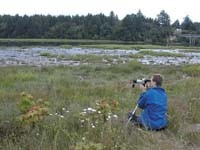Jesse Ellis follows his passion
Open gallery

Each year, millions of shorebirds flock to Willapa Bay, Wash. The bay’s fertile tide flats provide essential habitat as the birds stop to feed on invertebrate preys and to rest during annual migrations between the Tropics and the Arctic.
What better place for Jesse Ellis, a biology major and chemistry minor, to follow his passion—studying the behavior of birds?
“I’ve been interested in birds since I was small, and I also have an interest in ecology and evolution,” he notes.
But it wasn’t until he took a biology course, taught by Ken Clifton, assistant professor of biology, that he realized he could combine his varied interests through the study of animal behavior.
With fellowships from the John S. Rogers Science Research Program, Ellis spent the last two summers working with Clifton and other students at Willapa Bay. Their research focused on the feeding ecology of migrating shorebirds in threatened coastal wetlands.
“We began by asking, ‘Does the size of a flock affect the feeding behavior of the individual birds?’” Ellis says.
Using a stopwatch and spotting scopes, Ellis and his colleagues recorded the amount of time the birds spent feeding and the number of times the birds successfully caught something to eat. They spent hours painstakingly sifting through samples of mud to remove tiny worms and crustaceans. Back in the laboratory, they sorted and counted these organisms under a microscope to determine the abundance and diversity of life just under the surface.
“I learned that there’s more to studying animal behavior than watching animals,” Ellis comments.
“By keeping track of where each sample came from, we were able to convert these data into a map of the invertebrate abundance on the mud flats,” he says.
According to Ellis, the data suggest that feeding rates initially rise with flock size and that larger flocks enjoy higher levels of food intake. As flocks grow very large, however, these rates decline, probably because of increased competition among flock mates.
When Ellis returned to Portland last fall, he noticed that birds also enjoy life on Palatine Hill, and he decided to direct his senior honors thesis toward the social structure of Steller’s jays on campus.
Every morning since October, Ellis has walked the same loop and has stopped at 20 specific points to observe and to take notes.
“The study led to more questions than answers,” he says.
Two of the jays he banded showed up regularly and appeared to have their own territories. But two others disappeared for months and didn’t show up again until February—the busiest month for Steller’s jays on campus.
“What were they doing? Where were they? Why did they come back?” he asks. “I wish I had more years on campus to continue the study.”
But Ellis graduates this spring and will head for the East Coast next fall. He just learned that he’s been accepted into Cornell University’s prestigious graduate program in neurobiology and behavior.
“I will definitely be focusing on animal behavior,” Ellis says. “And Cornell is the best school in the nation in the field.”
He credits his research experiences at Lewis & Clark College for preparing him for this next step in his career.
“I’ve come a long way in four years,” Ellis comments. “Lewis & Clark’s biology program has done a good job teaching me to think like a scientist. I’m certainly not done learning, but this College has given me a good place to start and has provided a good background in science to enable me to pursue graduate school.”
-by Jean Kempe-Ware
More L&C Magazine Stories
Lewis & Clark Magazine is located in McAfee on the Undergraduate Campus.
MSC: 19
email magazine@lclark.edu
voice 503-768-7970
fax 503-768-7969
The L&C Magazine staff welcomes letters and emails from readers about topics covered in the magazine. Correspondence must include your name and location and may be edited.
Lewis & Clark Magazine
Lewis & Clark
615 S. Palatine Hill Road MSC 19
Portland OR 97219

